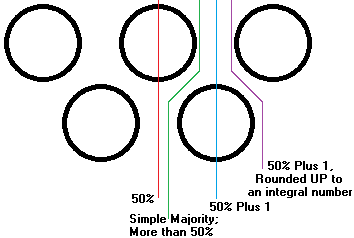CONVERSIONS
An alternative look at some conversion factors, other applications of units, and other numeracy issues.
Vehicle Fuel Economy
The standard units for vehicle fuel economy are miles per gallon and litres per 100 km.
One of these is a length divided by a volume, which has units of inverse area.
The other is a volume divided by a length, with units of area.
Fuel economy can be expressed as an area − the cross-sectional area required for a stationary tank,
the length of the intended journey, into which the vehicle may dip to extract fuel
and which the vehicle will exactly empty in the course of the journey.
A common unit of area, on the right order of magnitude, is the square millimetre.
Example: 10 litres per 100 km = 0.1 square millimetre.
Another unit of area − especially applicable to a cross-sectional area of capture − is the barn.
Example: 5 litres per 100 km = 500×1018 barns = 500 exabarns.
Tons of People
Based on a conservative 160 pounds per person, and a 2200 pound ‘long ton’,
Thus: It takes fewer than 14 people to make a ton; and
28 people, or more, constitutes ‘Tons of People’.
Debt versus Income
Debt may grow and shrink, but at any one time it is a fixed value.
Income is usually based on salary or another (semi) regular cash flow.
Thus the Debt to Income ratio is a ratio of a value versus a rate (a value per time-period);
and so the proper unit of measure for Debt versus Income is time.
A person with an annual income of $80,000, and a debt of $50,000,
has a debt to income ratio of 7.5 months; It will take 7.5 months worth of the income to pay off the debt.
(Of course, the debt will probably not be paid in 7.5 months: Some of the income will go elsewhere;
and Interest will cause the debt to grow – But those are other factors.)
With this in mind, it becomes obvious that there is little significant about debt rising above the level of the annual salary.
What relationship is there between money and the time it take the world to travel around the sun?
It is rising debt, and especially debt so big that the interest on it (a value-per-time) exceeds the the income (value-per-time),
which can be a cause for great concern.
“Fifty Percent Plus One” versus “Simple Majority” – WHY Invoke the former, not the latter?

Why (and where and when) has the requirement for a ‘Simple Majority’ been overtaken by a requirement for ‘50% + 1’?
As shown in the figure to the right:
When applied to an odd number, ‘50% + 1’ is greater than a simple majority
(note: rounding up is the only direction to go that does not loose, and therefore degrade, the stipulated ‘+1’.);
With small numbers, ‘50% + 1’ can be an overwhelming majority; and, perhaps more importantly –
What is to be done in the grey zone, when deciding a simple ‘A’ or ‘B’ proposition,
when a ‘simple majority’, but not ‘50% + 1’, has been achieved?
We could specify ‘50% + ½’ – but then that is just, needlessly, invoking a new term for the old ‘Simple Majority’.